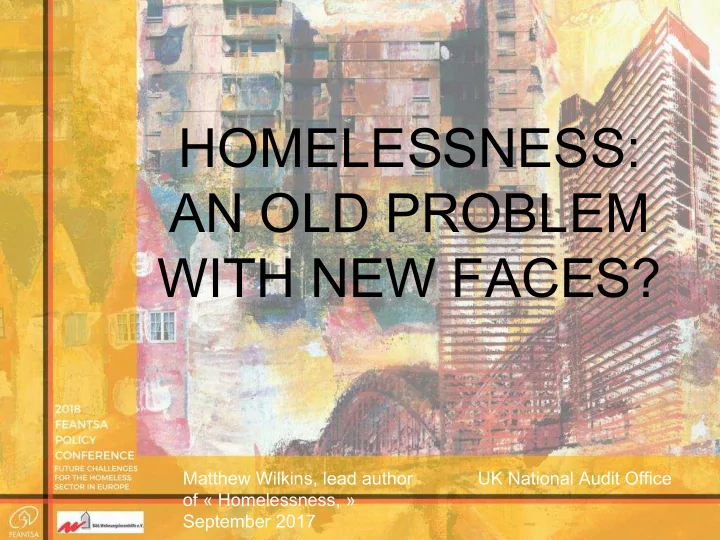

HOMELESSNESS: AN OLD PROBLEM WITH NEW FACES? Matthew Wilkins, lead author UK National Audit Office of « Homelessness, » September 2017
Ab About t the UK Na K Nation onal al Au Audit t Offic fice e (NAO AO) The National Audit Office (NAO) is entirely independent of government and scrutinises public spending on behalf of the British Parliament. We help Parliament to hold government to account, and aim to improve public services.
What do do we we mean by homeles essn snes ess? s? Most t homele lessn ssness ess is not visible, ible, and hidden n homelessne lessness ss is not offici iciall lly y measure red at all. Under English law, somebody is homeless if they have no accommodation, or it is not reasonable for them to continue to occupy the accommodation they have. Local authorities (councils) have a statutory duty to provide advice and assistance to all households that are homeless or are threatened with homelessness. Local authorities are also responsible for providing temporary porary accommoda ommodatio tion n to homeless households that are entitled to it in law. Government measures do not record homeless people staying with family or friends, in accommodation not provided by the local authority, or who have otherwise not come to the attention of the local authority .
The causes and costs of homelessness in England
Ke Key fact cts about ut homelessn essnes ess s in En England nd spring ing 2018 2018 The number of rough sleepers on one night t in the autumn of 2017 was 4,751, up by 15%, and the seventh consecutive year it increased (could be as high as 9,000). The number of rough sleepers doubled or nearly doubled in several boroughs in London – and is spreading beyond cities and towns. Mental illness and alcohol and drug dependency is typical among rough sleepers. 47% have mental health support needs, 44% have alcohol support needs and 35% have drug support need. More than 78,000 “households,” including 120,000 children, are housed in temporary accommodation. 22,000 households placed in temporary accommodation outside the council that recorded them as homeless e.g. London to Kent, Cardiff to Birmingham. English local government spent £1.15bn (1.3 bn Euros) on homelessness services during 2015-16.
Ho Homeles essn snes ess s in En England nd today ay is is highl hly visib sible le
What has cause sed d the increas ease e in homeles essn sness? ess? The long-standing risk of homelessness is greatest for families in areas of high economic activity on the margins of being able to pay market rents for their homes. Homelessness has also always been driven by personal factors, such as relationship breakdown and parents no longer being willing or able to house children in their own homes. However, the ending g of private ate sector tor tenanci ncies s has overtake rtaken n all other er causes es to become me the biggest st single e drive ver r of statutory tutory homelessne lessness ss. The proportion of households accepted as homeless by local authorities due to the end of an assured shorthold tenancy increased from 11% during 2009-10 to 32% during 2016-17. The proportion in London increased during the same period from 10% to 39%. Across oss England, and, the ending g of private vate secto tor r tenancies ncies accoun unts ts for 74% of the growth wth in househ ehold lds s who qualify ify for temporary porary accommoda ommodatio tion n since ce 2009-10. 10.
Th The endin ing g of priva vate te tenanc ncie ies s is the main cause se of homeles lessn snes ess s in En England nd today ay
Driver ers s of this is incre reas ase e in homele less ssne ness ss Afford rdab abili lity: ty: since 2010, the cost of private rented accommodation has increased three times faster than earnings across England. In London, the increase was eight times, with private rents rising by 24% and average earnings increasing by 3%. Welfa lfare e reform form: capping and freezing housing benefit led to a shortfall of £50 a week in London and £26 a week in the rest of England. Reduced duced supply upply: councils have less housing available due to polices such as Right to Buy.
Go Govern ernme ment nt respon ponse se to the increa rease se in homele less ssne ness ss Local cal gover vernme nment nt: : councils have increased their spending on homelessness while simultaneously reducing spending on preventing it. Nation onal al gove vernm nment ent: : has been ‘light touch’ e.g. no cross - government strategy. Has subsequently introduced legislation to increase prevention, and is working to improve data quality. Our r conclusion: nclusion: … the government took a light touch approach to working with local authorities. It is difficult to understand why it persisted with this approach in the face of such a visibly growing problem. It is only now beginning to put in place the measures that will allow it to maximise the effectiveness of the resources it directs at homelessness.
Co Conc nclu lusion and sion and Qu Ques estions tions
Recommend
More recommend